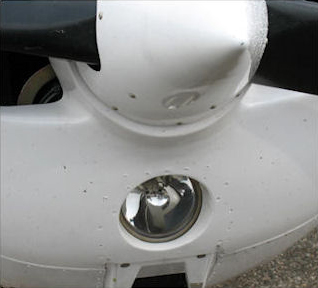Subscriber question:
"My instructor taught me to land at night without my landing light (with the runway lights on) in case the landing light ever failed. This has certainly come in handy over the years. So not so much a question as a suggestion: People really should learn this if they haven't before." —John T.
Ryan:
“ On my first nighttime flight as a private pilot, my landing light burned out. I didn’t know that until it failed to light up the landing runway, at which point I was happy I’d practiced landing without it in training.
On my first nighttime flight as a private pilot, my landing light burned out. I didn’t know that until it failed to light up the landing runway, at which point I was happy I’d practiced landing without it in training.
I make sure to do the same with my own students, which has revealed an interesting phenomenon: Students who struggle with the landing light on actually improve when it’s turned off. I think it’s because with the light they fixate on the small part of the pavement they can clearly see: the part lit by the landing light. If you stare at something, you’re probably going to hit it—and they hit the pavement hard. Without the landing light, their eyes naturally move down the runway and they take in a wider picture.
The primary risk, of course, is misjudging height in the roundout and flare. The FAA’s Airplane Flying Handbook suggests that the roundout should start ‘when the lights at the far end of the runway first appear to be rising higher than the nose of the airplane.’ Then it’s a matter of judging the flare. When the moon is out and the runway lights are bright, it’s not much different than a normal night landing. However, on an especially dark night it can feel like dropping into a black hole.
Seaplane pilots encounter a similar situation landing on clear, glassy water. The glassy-water technique involves setting a landing attitude and a shallow rate of descent, and waiting for touchdown. The same idea works for night landings without the landing light. Rather than trying for a full-stall landing, leave in a bit of power and slowly ease down, ‘feeling’ for the runway. The touchdown might be a bit firmer than usual, but that’s ok. It’s better than misjudging a full-stall flare, and dropping like a rock from 10 feet.
This technique can result in a longer landing, so it’s important to keep track of how much runway is left and set an appropriate abort point. For standard runway lights, it could be the point where the edge lights change from white to amber. That indicates either 2000 feet remaining or the last half of the runway, whichever is shorter.
Check all the aircraft lights on every preflight, even for day VFR. Too often, landing lights or position lights aren’t working when you need them most. That’s not a manifestation of Murphy’s Law—it’s the result of only checking them when they’re needed.”
Were you taught to land without a landing light and/or runway lights?
